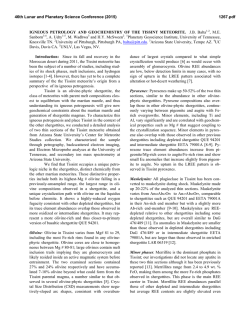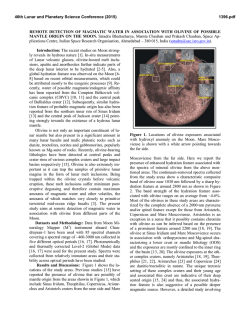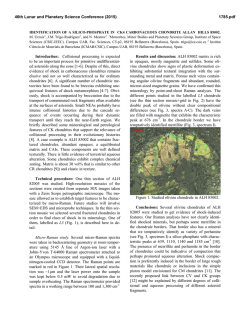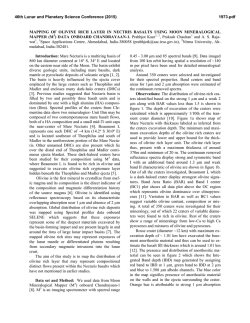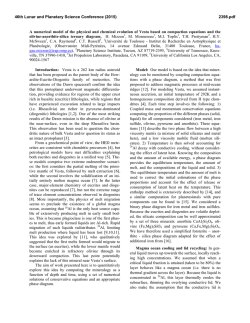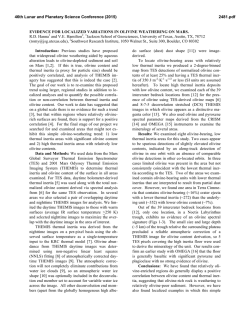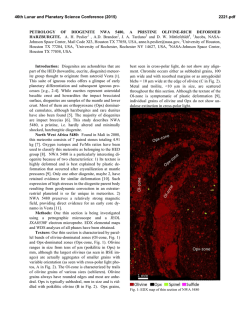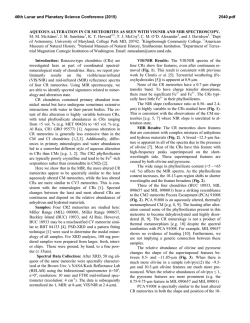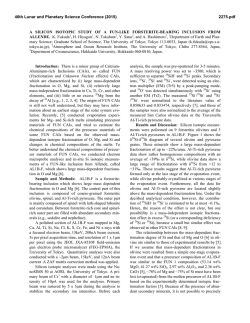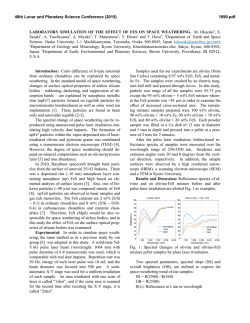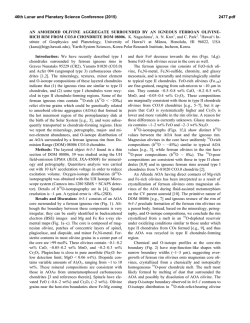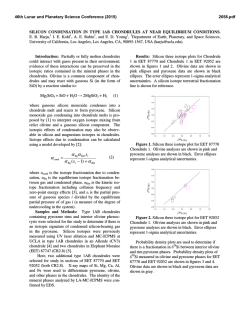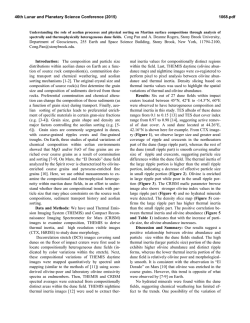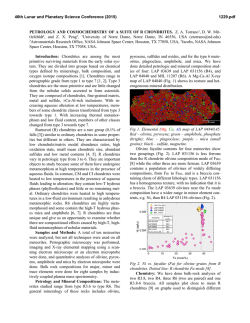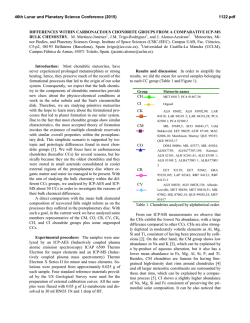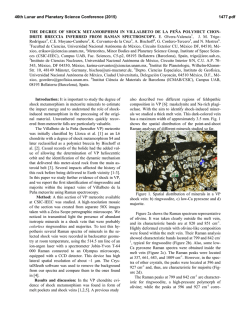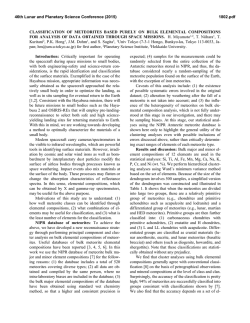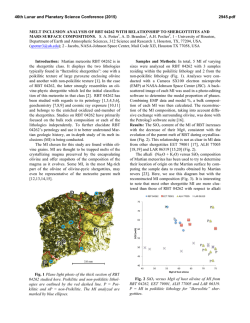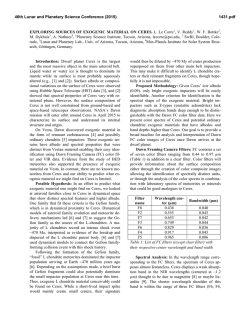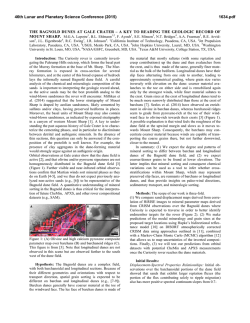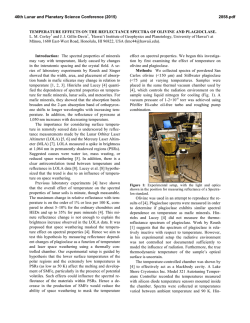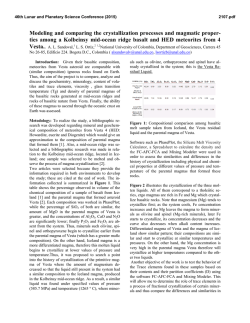
EXPLORING EXOGENIC SOURCES FOR THE OLIVINE ON
46th Lunar and Planetary Science Conference (2015) 1107.pdf EXPLORING EXOGENIC SOURCES FOR THE OLIVINE ON ASTEROID VESTA. L. Le Corre1, V. Reddy1, J. Sanchez1, T. Dunn2, E. A. Cloutis3, M. R. Izawa3, P. Mann3, A. Nathues4, 1Planetary Science Institute, 1700 East Fort Lowell, Suite 106, Tucson, AZ 85719, USA, [email protected], 2Colby College, Department of Geology, 5808 Mayflower Hill, Waterville, ME 04901, 3Department of Geography, University of Winnipeg, 515 Portage Avenue, Winnipeg, Manitoba, Canada, 4Max-Planck-Institute for Solar System Research, Göttingen, Germany. Introduction: Ground-based and Hubble Space Telescope observations of asteroid Vesta showed evidence for the possible presence of olivine. However, subsequent analysis of data from NASA’s Dawn mission proved that this “olivine-bearing unit”, identified as Oppia crater and its ejecta blanket, was composed of HED impact melt rather than olivine [1]. The lack of widespread olivine in the 19 km deep Rheasilvia basin on the South Pole suggests that the crust-mantle boundary was not breached during the formation of the basin, and that Vesta’s crust is thicker than originally anticipated [2]. Recently, local-scale olivine units have been reported in the walls and ejecta of two craters (Fig. 1), Arruntia (42 km in diameter) and Bellicia (11 km in diameter), located in the Northern Hemisphere of Vesta, 350-430 km from the Rheasilvia basin [3]. These units were interpreted as exposed plutons by [2] rather than of mantle origin excavated during the formation of the Rheasilvia basin. We explored alternative sources for these olivine-rich units by reanalyzing the data published by [3]. via basin and for the detection of olivine in unexpected locations in the Northern hemisphere. Endogenic olivine from plutons. Olivine formed in magmatic intrusions in the vestan upper crust in the form of plutons (or dikes) and was subsequently exposed by impact craters (as proposed by [2] and [3]). Endogenic olivine from mantle. Crystallization of the magma due to complete metling of parent body leading to the formation of an olivine mantle. Subsequent, catastrophic impact exposes the olivine-rich mantle and eject material in the northern hemisphere of Vesta (as proposed in [3]). Exogenous origin from A-type asteroids. Olivine could have been brought by olivine-rich A-type impactors, but as mentioned in [3] and [4] these asteroids are rare in the main asteroid belt, so this hypothesis was not favored in most recent work. Comparison with Olivine-OPX Mixtures: Our mineralogical analysis gives olivine abundance between 70-80 vol.%, consistent with those obtained previously (for example [4] found >60% of olivine). However, no single laboratory spectrum of olivineOPX mixture can accurately reproduce both the Band I shape and Band I center of the VIR data (Fig. 2), as well as the Band II center due to different pyroxene composition. Figure 1: VIR image mosaic from [3]. Olivine-rich exposures are shown in green. Morphology of the Olivine-Rich Deposits: Distribution of the olivine around the Arruntia and Bellicia craters has been described by [3] and [4]. The exposures range in size from a hundred meters to few kilometers. The olivine is found on crater walls (in high reflectance outcrops), secondary craters nearby, and in the ejecta blanket of Arruntia and Bellicia (radial distribution around the crater rim). As proposed by [5], the observed distribution suggests that these deposits could have originated from an ancient impact further North, such as the Albana crater (91 km in diameter). Proposed Options for the Origin of the Olivine: Several hypotheses have been proposed in order to account for the non-detection of olivine in the Rheasil- Figure 2: Plot of lab spectra of olivine-OPX and olivine-rich site from the Bellicia crater from Dawn VIR [3]. Alternatives Sources for the Olivine: Olivine-rich asteroids and meteorites. Several meteorites contain olivine that is not produce in the mantle (Table 1). [6] observed some olivine-rich asteroids matching the composition of R-chondrites. In addition, S-types asteroids with ordinary chondrite (OC)-like compositions contain a significant fraction of olivine. Other meteorites rich in olivine are CV chondrites, 46th Lunar and Planetary Science Conference (2015) pallasites, and primitive achondrites such as brachinites, ureilites, acapulcoites, lodranites (Table 1). Exogenous material in HEDs. Meteoritic evidence suggests contamination of HEDs by several exogenic impactors present in the form of clasts or diffuse in the impact melt breccia. HEDs show widespread contamination of Vesta by CM chondrites mostly, and this has been linked to the dark material observed on Vesta (e.g. [7]). Evidence for OC impactor remnants has also been found in howardites, such as Jiddat al Harasis 556 (JaH 556) with ~20 vol.% H chondrite material mixed with HED impact melt [8], but most OC xenoliths are less than 1 vol.% in HEDs [9]. OC is the second most abundant exogenic material in HEDs after carbonaceous chondrite material. Other exogenic materials observed by [9] include ureilite, acapulcoite/lodranite. 1107.pdf nary chondrite meteorites. The VIR data point falls in the L chondrite group within the S(IV) region and close to ureilite meteorites (near the S(III) zone). This suggests the olivine on Vesta could be from the contamination of the regolith by ordinary chondrites (possibly L), ureilites or mixtures of HED with some olivine-dominated meteorites such as R-chondrites. Figure 4: Continuum-removed spectra of areal mixtures of R-chondrite, pallasite and brachinite with eucrite NWA 7465. VIR data of olivine-rich unit is shown as dotted line. Table 1: Olivine abundance for different types of olivinebearing meteorites and summary of their presence in HEDs. Table adapted from [10]. Testing the Exogenic Olivine Hypothesis: Curve-matching of spectral data. We compared the VIR spectrum from [3] to spectra of various olivinerich meteorites (Table 1) (Fig. 3 shows some H chondrites), and mixtures of selected meteorites with eucrite Northwest Africa 7465 (NWA 7465) in an attempt to find a better fit (Fig. 4). Figure 3: Continuum-removed spectra of selected H chondrites from the RELAB database, compared to the olivinerich unit observed by VIR [3]. Band parameters comparison. The olivine-rich unit plots in the S(IV) region and slightly below the olivine-orthopyroxene mixing line (Fig. 5). Asteroids falling in the S(IV) region could be analogous to ordi- Figure 5: Plot of Band I center vs. BAR for different types of olivine-rich meteorites (data from RELAB) and the olivinerich site observed by VIR [3]. Ellipses define the various Sasteroid subtypes from [11]. Black curve is the olivine-OPX mixing line with pure olivine at the top left where BAR is 0. Summary: Based on exogenic materials in HEDs, the most likely contaminants are OC and possibly primitive achondrites. Curve matching suggests the presence of pure OC or mixtures of Rchondrite/brachinite/OC with eucrite-rich howardite. Therefore, the vestan olivine-rich unit could be explained by the delivery of exogenic material rich in olivine, this favors a recent model of Vesta with a deep crust/mantle boundary from [2]. References: [1] Le Corre, L. et al. (2013) Icarus, 226, 1568–1594 [2] Clenet, H. et al. (2014) Nature, 511, 303-306 [3] Ammannito, E. et al, (2013) Nature, 504, 122-125 [4] Thanglam, G. et al. (2014) MAPS 49,18311850 [5] Nathues A. et al. (in press) Icarus [6] Sanchez et al. (2014) Icarus 228, 288-300 [7] Reddy V. et al. (2012) Icarus 221, 544-559 [8] Janots, E. et al. (2012) MAPS 47, 1558-1574 [9] Lorenz K.A et al. (2007) Petrology 15,109-125 [10] Cloutis E.A. et al. (in press) Icarus [11] Gaffey M. J. et al. (1993) Icarus 106, 573-602. Acknowledgment: This research utilizes spectra acquired by Richard P. Binzel, Takahiro Hiroi, Tim McCoy, Harry Y. McSween, David W. Mittlefehldt, Carle M. Pieters, and Allan H. Treiman with the NASA RELAB facility at Brown University. This research work was supported by NASA Planetary Mission Data Analysis Program Grant NNX14AN16G, NASA Planetary Geology and Geophysics Grant NNX14AN35G.
© Copyright 2025
